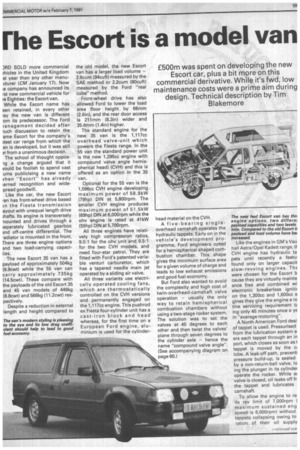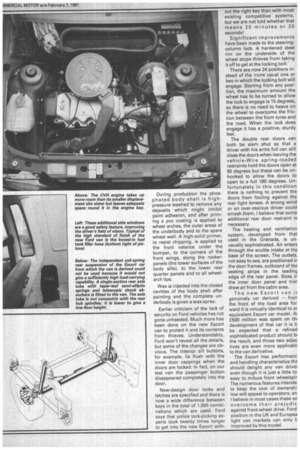The Escort is a model van
Page 61

Page 62

Page 63

If you've noticed an error in this article please click here to report it so we can fix it.
)RD SOLD more commercial ;hides in the United Kingdom st year than any other menucturer (CM January 17). Now le company has announced its rst new commercial vehicle for re Eighties: the Escort van.
While the Escort name has een retained, in every other iay the new van is different om its predecessor. The Ford lanagement decided after luch discussion to retain the arne Escort for the company's ;test car range from which the an is developed, but it was still 3r from a unanimous decision. The school of thought oppos-ig a change argued that it vould be foolish to spend vast urns publicising a new name
vhen "Escort" has already !arned recognition and wide pread goodwill.
Like the car, the new Escort ran has front-wheel drive based Hi the Fiesta transmission ayout with unequal length drive ;hafts. Its engine is transversely nounted and drives through a ;eparately lubricated gearbox 3nd off-centre differential. The -adiator is mounted in the front. there are three engine options 3 n d two load-carrying capacities.
The new Escort 35 van has a payload of approximately 504kg (9.9cwt) while the 55 van can carry approximately 735kg (14.5cwt). These compare with the payloads of the old Escort 35 and 45 van models of 446kg (8.8cwt) and 566kg (11.2cwt) respectively.
Despite a reduction in external length and height compared to the old model, the new Escort van has a larger load volume — 2.6cum (94cuft) measured by the SAE method or 2.2cum (80cuft) measured by the Ford "real cube" method.
Front-wheel drive has also allowed Ford to lower the load area floor height by 66mm (2.6in), and the rear door access is 211mm (8.3in) wider and 35.6mm (1.4in) higher.
The standard engine for the new 35 van is the 1,117cc overhead valve-unit which powers the Fiesta range. In the 55 van the standard power unit is the new 1,295cc engine with compound valve angle hemispherical head) (CVH) and this is offered as an option in the 35 van.
Optional for the 55 van is the 1,596cc CVH engine developing maximum power of 58.9kW (79hp) DIN at 5,800rpm, The smaller CVH engine produces maximum power of 51.5kW (69hp) DIN at 6,000rpm while the &iv engine is rated at 41kW (55hp) DIN at 5,700rpm.
All three engines have relatively high compression ratios, 9.0:1 for the ohv unit and 9.5:1 for the two CVH models, and need four-star petrol. They are fitted with Ford's patented variable venturi carburettor, which has a tapered needle main jet operated by a sliding air valve.
All three variants use electrically operated cooling fans, which are thermostatically controlled on the CVH versions and permanently engaged on the 1,117cc engine. This pushrod ex Fiesta four-cylinder unit has a cast-iron block and head whereas, for the first time on a European Ford engine, aluminium is used for the cylinder
head material on the CVH.
A five-bearing singleoverhead camshaft operates the hydraulic tappets. Early on in the vehicle's development programme, Ford engineers opted for a hemispherical shaped combustion chamber. This shape gives the minimum surface area for a given volume of charge and leads to low exhaust emissions and good fuel economy.
But Ford also wanted to avoid the complexity and high cost of twin-overhead-camshaft valve operation — usually the only way to retain hemispherical combustion chambers without using a two-stage rocker system. The solution was to set the valves at 45 degrees to each other and then twist the valves' plane through seven degrees to the cylinder axle — hence the name "compound valve angle". (See accompanying diagram on page 60.)
Like the engines in GM's Vau hall Astra/Opel Kadett range, tt CVH engine has hydraulic ta pets until recently a featui found only on larger capacit slow-revving engines. ThE were chosen for the Escort b cause they are virtually mainte ance free and combined wi electronic breakerless ignith on the 1,300cc and 1,600cc e gines they give the engine a ro tine servicing requirement tE. ing only 45 minutes once a yE in "average motoring".
A North American Ford desi of tappet is used. Pressurised from the lubrication system e ers each tappet through an in port, which closes as soon ast tappet is moved by the lobe. A leak-off path, preventi pressure build-up, is sealed by a non-return-ball valve, lo ing the plunger in its cylinder operate the rocker. While valve is closed, oil leaks off fr the tappet and lubricates camshaft.
To allow the engine to re its rev limit of 7,000rpm ( maximum sustained eng speed is 6,000rpm) without tappets collapsing owing to ration of their oil supply
umber of small changes had to e made to the engine during its evelopment. These included le adoption of five camshaft earings rather than three, vised cam profiles, lightweight rcker arms, less stiff valve )rings, and better drainage .tannels from the camshaft ack.
Low maintenance costs have ?en an essential aim in the degn of Ford's new light van. It is 3imed that engine seals, gas:ts, camshaft and main !arings can be changed withit removing the power unit )m the van (the CVH camshaft !arings are machined directly the parent metal).
The cable-operated diaphgm clutch has automatic cable justment, first used on Fiesta d now also fitted to Cortina d Granada, and the rear drum 3kes (leading-and-trailingoe) are self adjusting while ;cs are fitted to the front. No itine lubrication is necessary the transmission, steering, 3pension or door hinges.
Vhile some operators would efer to see some grease 'pies, Ford has followed the rrent trend in fitting for imple sealed-for-life steering its, and these reduce servictimes. Ford says that most erior panels can be repaired h ease; large internal access rtures help. The radiator le can be unclipped and reved without the use of tools, I bumper end caps are easily achable.
he new type of two-pronged 3 used is easier to change
gives a better electrical tact than the old type. A cenfusebox similar to the one d on the Granada can house to 18 fuses and nine relays. 3 fusebox is mounted on the ide of the front bulkhead, unleath the bonnet where it is My accessible, but it would better protected from rain mud if it were fitted inside van.
During production the phosphated body shell is highpressure washed to .remove any deposits which might inhibit paint adhesion, and after priming a pvc coating is applied to wheel arches, the outer areas of the underbody and to the spare wheel well. A high-solid primer, to resist chipping, is applied to the front valance under the bumper, to the corners of the front wings, along the rockerpanels (the lower surfaces of the body sills), to the lower rear quarter panels and to all wheelarch lips.
Wax is injected into the closed cavities of the body shell after painting and the complete underbody is given a wax spray.
Earlier criticism of the lack of security on Ford vehicles has not gone unheeded. Much more has been done on the new Escort van to protect it and its contents from thieves. Understandably, Ford won't reveal all the details, but some of the changes are obvious. The interior sill buttons, for example, lie flush with the inner door cappings when the doors are locked. In fact, on our test van the passenger button disappeared completely into the door.
New-design door locks and latches are specified and there is now a wide difference between keys in the total of 1,000 combinations which are used. Ford says that police lock-picking experts took twenty times longer to get into the new Escort with
out the right key than with most existing competitive systems, but we are not told whether that means 20 minutes or 20 seconds!
Significant improvements have been made to the steeringcolumn lock. A hardened steel rim on the underside of the wheel stops thieves from taking it off to get at the locking bolt.
There are now 24 positions instead of the more usual one or two in which the locking bolt will engage. Starting from any position, the maximum amount the wheel has to be turned to allow the lock to engage is 15 degrees, so there is no need to heave on the wheel to overcome the friction between the front tyres and the road. When the lock does engage it has a positive, sturdy feel.
The double rear doors can both be slam shut so that a driver with his arms full can still close the doors when leaving the vehicle-Wire spring-loaded restraints hold the doors open at 90 degrees but these can be unhooked to allow the doors to open to a full 180 degrees. Unfortunately in this condition there is nothing to prevent the doors from fouling against the rear light lenses. A strong wind or an over-zealous driver could smash them. I believe that some additional rear door restraint is necessary.
The heating and ventilation system, developed from that used in the Granada, is unusually sophisticated. Air enters through the scuttle intake at the base of the screen. The outlets, not easy to see, are positioned in the door frames, outboard of the seating strips in the leading edge of the rear panel. Slots in the inner door panel and trio' draw air from the cabin area.
The new Escort van genuinely car derived — frorr the front of the load area for ward it is virtually identical to ar equivalent Escort car model. A: £500 million was spent on thi development of that car it is t< be expected that a refined sophisticated product should ID( the result, and those two adjec tives are even more applicabli to the van derivative.
The Escort has performanc, and handling characteristics tha
should delight any van drivel even though it is just a little to easy to induce front wheelspir The numerous features intende to keep the cost of ownershi low will appeal to operators, an I believe in most cases these wi overcome their prejudic against front-wheel drive. Ford' position in the UK and Europea light van markets can only b improved by this model.












































































































